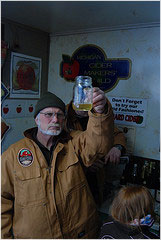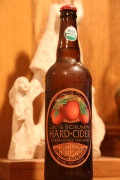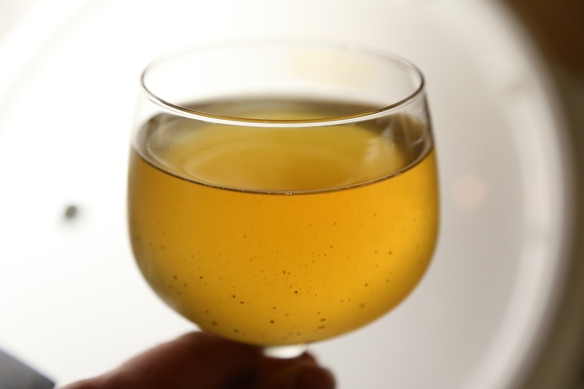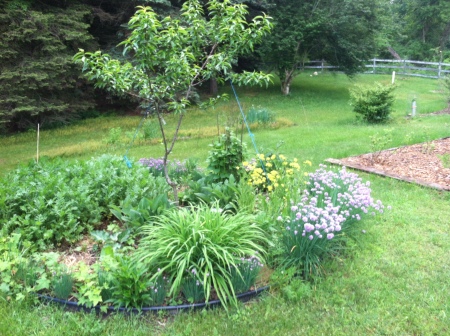 This weeks cider review comes from Flushing Michigan’s finest: Almar Orchards. Almar is one of the few certified organic apple orchards in southeast MI. Using integrated pest management the Koan family grows over 30 apple cultivars on their 500 acre farm. They also raise grains and livestock including pigs which feed on spent apple pomace after pressing! All of the apples used to make J.K.’s Scrumpy Hard Cider are grown, harvested, pressed, and fermented on the farm.
This weeks cider review comes from Flushing Michigan’s finest: Almar Orchards. Almar is one of the few certified organic apple orchards in southeast MI. Using integrated pest management the Koan family grows over 30 apple cultivars on their 500 acre farm. They also raise grains and livestock including pigs which feed on spent apple pomace after pressing! All of the apples used to make J.K.’s Scrumpy Hard Cider are grown, harvested, pressed, and fermented on the farm.
CLICK HERE TO SEE A VIDEO OF ALMAR ORCHARDS
A testament to their holistic orcharding and cider making practices from Almar owner, Jim Koan:
“This Original Hard-Cider has been made on our family-owned farm in Flushing, Michigan for well over a hundred years. It was first pressed back in the 1850’s. Not much as changed in the process since then. We use the same apples from the same orchards as my great-great grandfather did before the time of the Civil War. We are proud of that. It gives us a sense of history….
Our cider is not only natural, it is truly organic. It always has been. It’s simply a fact of what we do – and how we do it. We use no insecticides in the farm orchards. Rather, I do what my grandfather did. I have a large flock of guinea fowl that wander about and eat the bugs. Fallen apples that have hit the ground are always a food source for pests, so I let my Berkshire pigs wander the orchard and eat the fallen apples. In a fast-paced, instant gratification society all this may seem a little old fashioned, or not “cost-effective.” But, we have a cider that is not like any other, and the idea of playing around with what makes that happen… well, it just ain’t part of the plan.”
 They bottle various ciders including their Northern Neighbor Saskatoon Cuvee and J.K.’s Cuvee Winteruption (both of which will be looked at in upcoming reviews). This week’s review will cover their flagship cider known as Orchard Gold Gate. As the label implies, their ciders resemble ‘scrumpy’ ciders from England in that they’re produced in small batches using traditional methods. As a sentiment to the terrior and craft nature of J.K.’s Scrumpy Cider Jim Koan proclaims:
They bottle various ciders including their Northern Neighbor Saskatoon Cuvee and J.K.’s Cuvee Winteruption (both of which will be looked at in upcoming reviews). This week’s review will cover their flagship cider known as Orchard Gold Gate. As the label implies, their ciders resemble ‘scrumpy’ ciders from England in that they’re produced in small batches using traditional methods. As a sentiment to the terrior and craft nature of J.K.’s Scrumpy Cider Jim Koan proclaims:
“I consider Orchard Gate Gold as a unique Artisan Michigan Farmhouse Cider, somewhere between English Scrumpy and a Normandy Cidre.
The bottom line is that it could not be made anyplace else. It is reliant on the soil and the climate. Open a bottle and decide for yourself!
After the harvest, we press our organic apples and allow them to slowly ferment for up to six months. We then carefully hand-fill and label each bottle and let it age for several weeks to properly condition.”
Orchard Gate Gold and the rest of the J.K.’s Scrumpy cider line are readily available throughout MI and can be found in 17 other states. Orchard Gate Gold is sold for around $8.99 and weighs in at 6% ABV. Upon pouring the cider is hazy and lacks clarity. Bits of yeast and lees float in the bottle. It has a beautiful golden straw color and the aroma grabs you immediately—it’s somewhere between butterscotch and caramel with the aromatics common of fresh apple juice. The flavor is reminiscent of apple juice left in the fridge to slowly ferment for a month or two. It is very sweet with high residual sugar and has virtually zero sharpness or bitterness. What I’d call a dessert cider. The booziness distinctly pulls through and complements the nearly overbearing sweetness. This cider is certainly not sparkling but it does posses a subtle effervescence— I believe it’d be referred to as a perlant cider. The slight bubliness adds a pleasant mouth feel that also supports and balances the high sweetness. For a sweet dessert cider it is very agreeable and nice, but for me, drinking more than a glass would be too much. I’d imagine Orchard Gold Gate would be lovely served warm and mulled. Stay tuned for coming reviews of other ciders in the J.K.’s Scrumpy Hard Cider line. Cheers!


